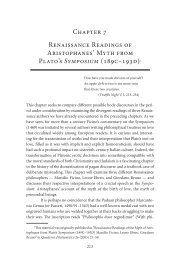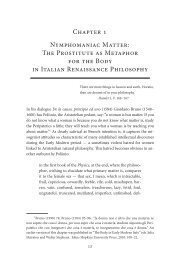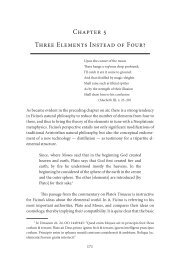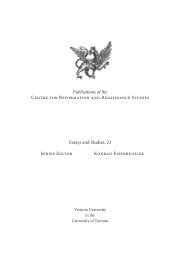Chapter 2 Matter as a Mirror: Marsilio Ficino and Renaissance ...
Chapter 2 Matter as a Mirror: Marsilio Ficino and Renaissance ...
Chapter 2 Matter as a Mirror: Marsilio Ficino and Renaissance ...
You also want an ePaper? Increase the reach of your titles
YUMPU automatically turns print PDFs into web optimized ePapers that Google loves.
<strong>Matter</strong> <strong>as</strong> a <strong>Mirror</strong> 69<br />
The version of the myth from the Corpus hermeticum uses a decidedly<br />
heterosexual metaphor to account for the relationships between bodies <strong>and</strong><br />
souls. Male soul gets attracted by beautiful female matter <strong>and</strong> eventually falls<br />
for her, without recognizing her <strong>as</strong> his own image in the material world. This<br />
again marks a significant departure from the Ovidian version of the myth of<br />
Narcissus, who consciously perceives the image in the pond <strong>as</strong> his own reflection<br />
<strong>and</strong> eventually perishes in the activity of self-speculation. Ovid shows<br />
unequivocally that Narcissus is in love with the reflection he perceives <strong>as</strong><br />
male, since it is his own image. The myth is thus set in a homoerotic context<br />
characteristic of the social <strong>and</strong> political situation in cl<strong>as</strong>sical Greece. 72 The<br />
later suppression of the homoerotic context of the Narcissus myth emph<strong>as</strong>izes<br />
the deceptive potential of the mirror. 73 Much later <strong>and</strong> closer to <strong>Ficino</strong>’s<br />
cultural environment, Boccaccio recounts another heterosexual version of<br />
the myth that underscores this <strong>as</strong>pect of deception through, or transformation<br />
in, a mirror. According to Boccaccio, Narcissus misapprehends the sight of<br />
his face <strong>as</strong> that of a beautiful female, a nymph, in which c<strong>as</strong>e the reflection<br />
in the mirror implies the disfigurement of the sexual identity of the onlooker<br />
by the reflection of a mirror. Here the mirror is understood <strong>as</strong> an instrument<br />
that transforms the images it reflects. 74<br />
unit<strong>as</strong> spiritus cum corpore.” The Arab original version continues, Picatrix German 22 :<br />
“oder wie sich Gottsein und Menschsein in der Lehre der Christen vereinigen.”<br />
72 In Ovid’s Metamorphoses III, 455, trans. Ovid (1955) 86, Narcissus cries out “Whoever<br />
you are, come out to me! Oh boy beyond compare, why do you elude me?” According<br />
to Hadot (1967) 93, Ovid is the only author in Cl<strong>as</strong>sical Antiquity who suggests that<br />
Narcissus is not entirely deceived by the reflection in the water.<br />
73 I am conscious that the terms homoerotic <strong>and</strong> heterosexual are perhaps anachronistic;<br />
in the present context, they are used only to denote sexual relationships between<br />
males or between men <strong>and</strong> women <strong>and</strong> not the constitution of subjective identities (see<br />
also chapter seven).<br />
74 Boccaccio (1574) 131: “nel chiaro ed limpidoso fonte, del quale veggendo l’idea,<br />
e la imagine di se stesso che prima non havea mai piu veduto, et istim<strong>and</strong>o quella essere<br />
una ninfa di quel fonte, tanto di lei si fieramente s’accese, che di se medesimo scord<strong>and</strong>osi,<br />
dopo lunghi lamenti ivi mori di disagio, et per comp<strong>as</strong>sione della ninfe fu cangiato in fiore<br />
che tiene il suo nome.” On Boccaccio’s reading of the Narcissus myth <strong>and</strong> of the role of<br />
Echo <strong>as</strong> an allegory of fame, see Vinge (1967) 102–103. For a brilliant analysis of Pausani<strong>as</strong>’<br />
heterosexual version of the story, which <strong>as</strong>sumes that Narcissus had a twin sister who<br />
dies <strong>and</strong> is subsequently recovered by Narcissus when looking at his own face in a pond,<br />
in which the female becomes a “garçon manqué,” see Frontisi-Ducroux (1997) 217–219.







